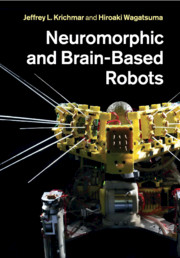Book contents
- Frontmatter
- Contents
- Contributors
- Preface
- Part I Introduction
- Part II Neuromorphic robots: biologically and neurally inspired designs
- Part III Brain-based robots: architectures and approaches
- 5 The RatSLAM project: robot spatial navigation
- 6 Evolution of rewards and learning mechanisms in Cyber Rodents
- 7 A neuromorphically inspired architecture for cognitive robots
- 8 Autonomous visuomotor development for neuromorphic robots
- 9 Brain-inspired robots for autistic training and care
- Part IV Philosophical and theoretical considerations
- Part V Ethical considerations
- Index
- References
8 - Autonomous visuomotor development for neuromorphic robots
from Part III - Brain-based robots: architectures and approaches
Published online by Cambridge University Press: 05 February 2012
- Frontmatter
- Contents
- Contributors
- Preface
- Part I Introduction
- Part II Neuromorphic robots: biologically and neurally inspired designs
- Part III Brain-based robots: architectures and approaches
- 5 The RatSLAM project: robot spatial navigation
- 6 Evolution of rewards and learning mechanisms in Cyber Rodents
- 7 A neuromorphically inspired architecture for cognitive robots
- 8 Autonomous visuomotor development for neuromorphic robots
- 9 Brain-inspired robots for autistic training and care
- Part IV Philosophical and theoretical considerations
- Part V Ethical considerations
- Index
- References
Summary
Introduction
It has been a huge challenge to program autonomous robots for unstructured and new environments. Various modules are difficult to program and so is the coordination among modules and motors. Existing neuroanatomical studies have suggested that the brain uses similar mechanisms to coordinate the different sensor modalities (e.g. visual and auditory) and the different motor modalities (e.g. arms, legs, and the vocal tract). Via sensorimotor interactions with the robot’s internal and external environments, autonomous mental development (AMD) in this chapter models the brain as not only an information processor (e.g. brain regions and their interconnections), but also the causality for its development (e.g. why each region does what it does). The mechanisms of AMD suggest that the function of each brain region is not preset statically before birth by the genome, but is instead the emergent consequence of its interconnections with other brain regions through the lifetime experience. The experience of interactions not only greatly shapes what each region does, but also how different regions cooperate. The latter seems harder to program than a static function. As a general-purpose model of sensorimotor systems, this chapter describes the developmental program for the visuomotor system of a developmental robot. Based on the brain-inspired mechanisms, the developmental program enables a network to wire itself and to adapt “on the fly” using bottom-up signals from sensors and top-down signals from externally supervised or self-supervised acting activities. These simple mechanisms are sufficient for the neuromorphic Where What Network 1 (WWN-1) to demonstrate small-scale but practical-grade performance for the two highly intertwined problems of vision – attention and recognition – in the presence of complex backgrounds.
Information
- Type
- Chapter
- Information
- Neuromorphic and Brain-Based Robots , pp. 156 - 177Publisher: Cambridge University PressPrint publication year: 2011
